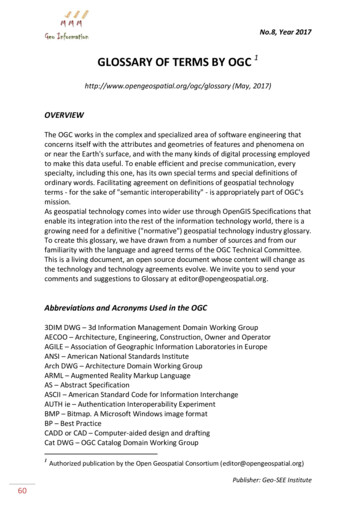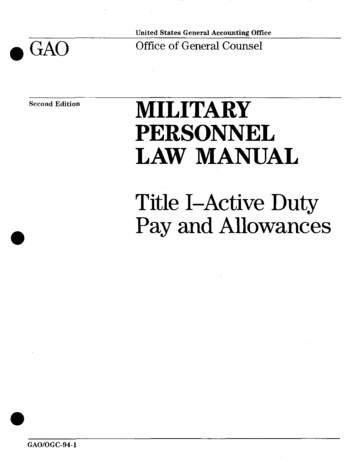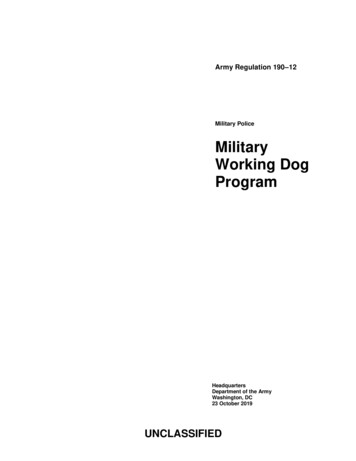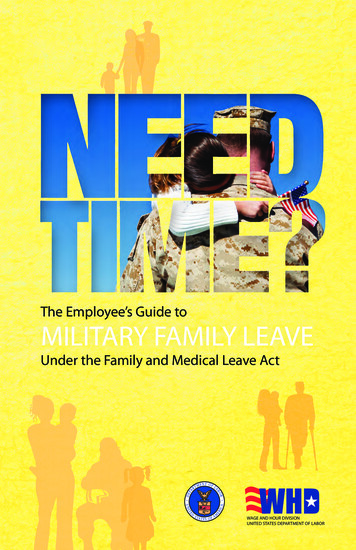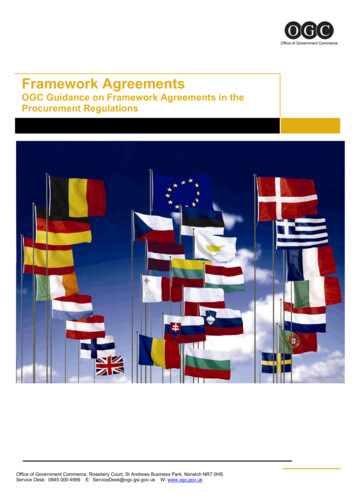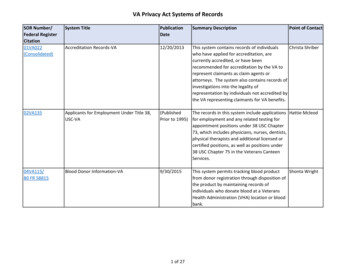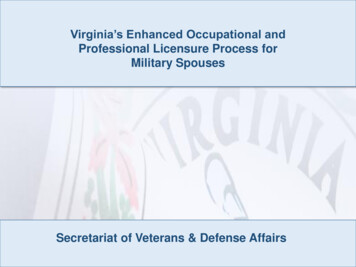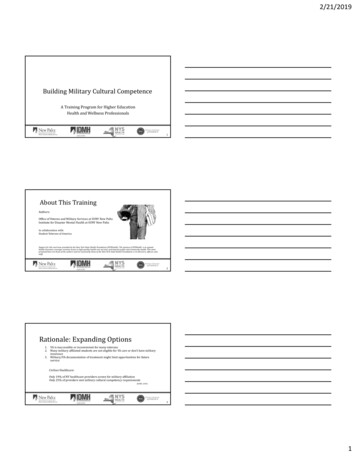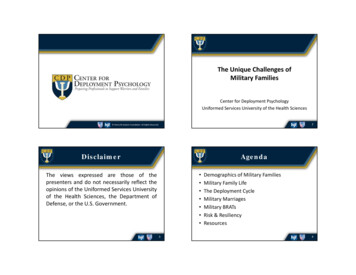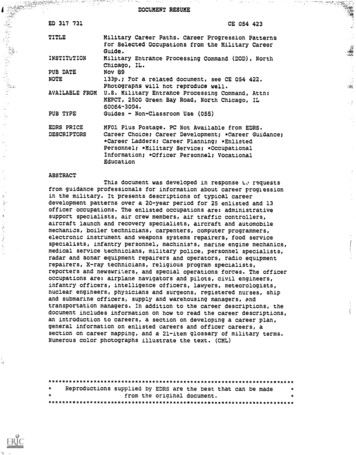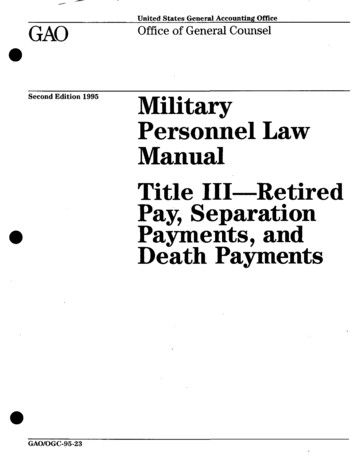
Transcription
United States General Accounting OfficeGAOOffice of General CounselSecond Edition 1995MilitaryPersonnel LawManualTitle III—RetiredPay, SeparationPayments, andDeath PaymentsGAO/OGC-95-23
ForewordThis is Title III of the Second Edition of the Military Personnel LawManual. The Manual is prepared by the Office of General Counsel, U.S.General Accounting Office (GAO). The purpose of the Manual is to presentthe legal entitlements of members of the uniformed services including anoverview of the statutes and regulations which give rise to thoseentitlements, in the following areas: Titie I— Active Duty Pay andAllowances; Titie U—Travel; Titie III—Retired Pay, Separation Payments,and Death Benefits; and Titie IV—Survivor Benefit Plan.This edition of the Military Personnel Law Manual is being published inloose leaf style with the introduction and four tities separately wrapped.The Manual generally reflects decisions of this Office issued throughSeptember 30,1992. The material in the Manual is, of course, subject torevision by statute or through the decision-making process. Accordingly,this Manual should be considered as a general guide only and should notbe cited as an independent source of legal authority. This Manualsupersedes the edition of the Military Personnel Law Manual which waspublished in June 1983 with revised pages issued May 1985, coveringdecisions through December 31, 1984.We plan to issue regular supplements to be filed with this edition of theMilitary Personnel Law Manual. As always, we would welcome anycomments that you may have regarding any aspect of the Manual.Robert P. MurphyGeneral CounselPage 1GAO/OGC-95-23 MPLM—Retired P a y
ContentsForewordTitle m—Retired Pay,Separation Payments,and Death PaymentsMChapter 1—Retirement for Yearsof Service and forNon-Regular ServiceMChapter 2—RetiredPay for DisabilityRetirement2-1Chapter 3—Pay forMilitary ServicePerformedSubsequent toRetirement3-1Chapter 4—DualCompensationRestrictionsSubchapter I—Retirement StatusSubchapter II—Nongovernment Employment Not CoveredSubchapter III—Government EmplojTnentSubchapter IV—Pay Reduction and Refunds4-1444-64-13Chapter5—Constitutional andStatutory ProhibitionAgainst Payment ofRetired PaySubchapter 1—Constitutional Prohibition AgainstForeign EmploymentSubchapter n—Selling to the Government5-15-9Page contents-1GAO/OGC-95-23 MPLM—Retired Pay
ContentsChapter6—SeparationPaymentsSubchapter I—Accrued Leave PaySubchapter n—Disability Severance PaySubch ter IH—Repeals in 19816-16-116-16Chapter 7—DeathPaymentsSubchapter 1—Death GratuitySubchapter II—Deceased Member's Pay and Allowances7-17-15IndexCh ter 1—Retirement for Years of Service and forNon-Regular ServiceChEqjter 2—Retired Pay for Disability RetirementChapter 3—Pay for Military Service Performed Subsequentto RetirementChapter 4—Dual Compensation RestrictionsSubchapter I—Retirement StatusSubchapter II—Nongovernment Employment NotCoveredSubchj ter III—Government EmploymentSubch ter IV—Pay Reduction and RefundsChapter 5—Constitutional and Statutory ProhibitionAgainst Payment of Retired P Subchapter I—Constitutional Prohibition AgainstForeign EmploymentSubchapter II—Selling to the GovenimentChapter 6—Separation PaymentsSubchapter I— Accrued Leave PaySubchapter II—Disability Severance PaySubchapter in—Repeals in 1981Chapter 7—Death PaymentsSubchapter 1—Death GratuitySubchapter II—Deceased Member's Pay and active duty trainingAir ForceArmy of the United StatesAir Force RegulationPage contents-2GAO/OGC-95-23 MPLM—Retired Pay
ContentsBASBAQcf.c.F.R.ch.CIACMAcocCOLAComp. Gen.CONUSct csbasic allowance for subsistencebasic allowance for quarterscompareCode of Federal RegulationschapterCentral Intelligence AgencyCourt of Military AppealsOffice of the Comptroller of the Currencycost of living allowanceDecisions of the Comptroller General of theUnited States (published volumes)the continental United StatesCourt of ClaimsDependency and Indemnity CompensationDo-It-Yourselfdislocation allowanceDepartment of DefenseFederal Deposit Insurance Corporationfamily separation allowanceGeneral Accounting Officegovernment transportation requesthousehold effectshousehold goodsHealth Profession's Scholarship Programinterim housing allowanceJoint Federal Travel Regulations, Vol. 1(formerly Joint Travel Regulations, Vol. 1)Joint Travel Regulations, Vol 1 (now Joint FederalTravel Regulations, Vol. 1)Junior Reserve Officers' Training Corpsleave without payMarine Corps Associate Degree Completion Programmobile homemissing in actionmilitary occupational specialtyMilitary Persormel Law Manualmilitary sea c o m m a n dmultiple unit training assembly-twoNaval Academy Athletic AssociationNorth Atlantic Treaty OrganizationNavy Reserve Officers' Training CorpsOfficer Candidate SchoolPage contents-3GAO/OGC-95-23 MPLM—Retired Pay
Contentsparaparas.PCSPDTATACPHSpovPub. L. No.ROTCRSFPPSEPSRBSROTCStat.TAD"TAPER"par rs hparagr hsp e r m a n e n t change of stationPer Diem Travel and TransportationAllowance CommitteePublic Health Serviceprivately o w n e d vehiclePublic Law NumberReserve Officers Training CorpsRetired Serviceman's Family Protection Plansurvivor Benefit Planselective reenlistment bonussenior Reserve Officers* Training Corpsstatutes at Largetemporary additional dutyappointment temporary appointment pending establishmentof a registerTURLT e m p o r a r y DisabOity Retired l i s mporary dutytemporary lodging allowanceUniform Code of Militaiy JusticeUnited States CodeUnited States Code AimotatedUnited States Marine CorpsUiuform Service Savings Deposit ProgramVeterans Administration (now Department of Veterans Affairs)variable housing allowancevolimievariable incentive paysectionsectionsPage content5-4GAO/OGC-95-23 MPLM—Retired Pay
Chapter 1Retirement for Years of Service and forNon-Regular ServiceA. R e t i r e d G r a d el. Grade at time of retirementa Time-in-grade restrictions(1) Inapplicable in selecting retirement date—Where an Army or Air ForceOfficer is retired in the grade of lieutenant general or general under10 u.s.c. §§ 3962 or 8962, the time-in-grade restrictions in 10 u.s.c §§ 3963or 8963 (both repealed in 1985) do not p l y in selecting an earlierhypothetical retirement date for retired pay computation pursuant to10U.S.C. § 1401a(f). B-189029, Sept 9, 1980.(2) Failure to meet—Members of the Armed Services, whether officer orenlisted, who have not met the requirements prescribed by statute andregulation of time-in-grade for retirement in a certain grade may not havetheir retired pay computed on the basis of the higher grade throughoperation of 10 use. § 1401a(f) unless a waiver of that requirement hasbeen granted pursuant to proper authority. Chief Master Sergeant E. Ohr,USAF, 68 Comp. Gen. 649 (1989).b. Member reduced after becoming eligible for retirementUnder 10 use. § 1401a(f) the retainer pay of a former Navy or MarineCorps member who initially became entitied to that pay on or afterJanuary 1,1971, may not be less than the retainer pay to which he wouldbe entitled if transferred to the Fleet Reserve or Fleet Marine CorpsReserve at an earlier date, ac usted to reflect apphcable increases in suchpay under that section even though transferred to Fleet Reserve or FleetMarine Corps Reserve at a lower pay grade because of unsatisfactoryperformance of duty or as result of disciplinary action. 56 Comp. Gen. 740(1977).c. Grade prior to terminal leave or at time of retirementThe Air Force (special pay grade) prior to entering terminal leave status, atwhich time his status reverted to Chief Master Sergeant (pay grade E-9),and who retired under 10 u.s.c. § 8917 effective November 1, 1981, may becomputed based on the special rate for Chief Master Sergeant of the AirForce in effect prior to his commencing terminal leave or on the basis ofthe grade in which he was serving at the time of his retirement as a ChiefMaster Sergeant. B-210789, July 6,1983.Pa«e 1-1GAWOGC-95-23 MPLM—Retired P a y
Chapter 1Retirement for Years of Service and forNon-Regular Service2. Advancement on retired list to highest grade satisfactorily helda In generalWhere an existing statute authorizes computation of the retired pay of amember or former member on the basis of the pay of the grade in whichthe individual has served satisfactorily and which is higher than the pay ofthe grade on which he otherwise is entitied to compute his retired pay, wewill authorize payment, or pass to credit in the disbursing officer'saccounts, a payment of retired pay computed on the pay of the highergrade, without regard to whether that grade was a temporary orpermanent grade, even though the armed service in which the individualheld that higher grade is not the service m which he retired. However,such action in any particular case will depend upon an p r o p r i a t eadministrative determination as to satisfactory service where suchdetermination is required by applicable statutes. 49 Comp. Gen. 618 (1970).See also 50 Comp. Gen. 607 (1971); 50 Comp. Gen. 586 (1971); 49 Comp.Gen. 113 (1969); and 48 Comp. Gen. 163 (1968).b. Advancement in grade on retirement Usts— pay not recalculatedTwo retired officers of the Air Force were advanced firom the grade ofUeutenant general to general on the retirement lists. When retired servicemembers are advanced in grade on the retirement lists, their retired paymay not be recalculated to reflect their advancement in the absence ofstatutory authority directing a recalculation. In this case, there does notappear to be an Act of Congress authorizing a recalculation of the officersretired pay, nor does it p e a r that an increase in their pay was everintended to result from their advancement on the retirement lists. In thesecircumstances the Comptroller General is unable to conclude that they areeUgible for an increase in the rate of their retired pay. B-224142, Nov. 28,1986.c. Determination of "satisfactory service" in higher gradeWhile no amount of service is specified in 10 u s e , § 6151 before theSecretary of the Navy can determine that a member has servedsatisfactorily in a higher grade or rank under a temporary appointment tobe entitied to retired pay based on the higher grade, unless active serviceis actually performed in the temporary grade under conditions requiringduty comparable to that encountered during a normal tour of active duty,there would be no evidence upon which a determination of satisfactoryservice could be made. Therefore, 10 u s e . § 6151 must be construed asPage 1-2GAO/OGC-95-23 MPLM—Retired Pay
Chapter 1Retirement for Years of Service and forNon-Regular Servicecontemplating that the determinations will be made on the basis ofsufficient actual service in the temporary grade to permit a genuineappraisal of the quality of the service of the member in that grade.41 Comp. Gen. 11(1961).Marine Corps board of inquiry recommended to the Secretary that a mzgorbe retired in the rank of obtain and that the member had not servedsatisfactorily as a m or. Even though the m or first became eUgible forvoluntary retirement before the board's recommendation was approved bythe Secretary, his retired pay should be calculated on the grade of captain,since it is evident that the Secretary would not have made the statutorilyrequired determination of satisfactory service as a mtyor on the eligibilitydate. Captain William G. Peters, U.S. Marine Corps (Retired), 70 Comp.Gen. 398 (1991).d. Promotions while in missing status do not require 6-month in-graderequirementsSurvivor Benefit Plan annuity for the surviving spouse of member whodies while on active duty when otherwise eligible to retire, is computed ongrade and years of service as though member retired on the day he died.Computation includes limitations on grade for retirement purposes suchas the 6-month in-grade requirement. However, where a member who wasmissing in action is determined to have been killed in action, the 6-monthin-grade requirement does not apply since promotions received while in amissing status are "fully effective for aU purposes," under 37 use. § 552(a).B-195625, Feb. 28,1980.e. Retired pay for extraordinary heroism award—effect of advancement toofficer gradeA master sergeant who when retired under 10 u.s.c. § 3914 is awarded a10-percent increase in retired pay by reason of extraordinary heroismperformed in the line of duty, upon advancement to the officer rank ofcaptain on the retired list pursuant to 10 use. § 3964, is not eligible tocontinue receiving the 10-percent additional retired pay authorized onlyfor enhsted members, the entitiement to the increase not attaching byreason of his retirement, 10 us.c. § 3992, which prescribes the formula forthe recomputation of retired pay for members advanced on the retired list,does not provide a 10-percent increase in retired pay for extraordinaryheroism. Thus, the member's recomputed retired pay may not be increasedPage 1-3GAO/OGC-95-23 MPLM—Retired Pay
Chapter 1Retirement for Years of Service and forNon-Regular Servicefrom the date of his advancement on the retired list to the rank of c t a i nby 10 percent 47 Comp. Gen. 397 (1968).f. Advancement on retired list produces reduction of retired payA member received a lesser rate of retired pay in the recomputation of hisretired pay, in accordance with 10 u s e . § 3992, upon advancement towarrant officer, W-1, on the retired list after completion of 30 years ofservice, pursuant to 10 u s e . § 3964, than that established under 10 u.s.c.§ 3991 when originally retired under the authority of 10 u s e . §§ 3914 and3961 in the grade of sergeant E-9, a higher enlisted pay grade prescribed bythe Act of May 20,1958, than that of warrant officer, W-1, the membershould have been consulted before being advanced on the retired list,section 3964 not imposing an absolute requirement for advancement, andneither the most favorable payment formula authorized by section 3991,nor any other provision of law saved to the member the right to continuereceiving retired pay under his original entitiement Therefore, the actionof advancement may be rescinded on the basis of a statement by themember that it was contrary to his wishes. 44 Comp. Gen. 510 (1965).g. Correction of records to show retirement and subsequent ad\ ncementto officer gradeUpon correction of military records, to show retirement as a private E-1with over 20 years of service, in Ueu of discharge from the Regular Army,and advancement on the retired list to first Ueutenant, the retired pay ofthe member for the period from date of initial retirement to date of recordcorrection is not subject to recomputation under 10 u s e . § 3992 at therates prescribed in section 511 of the Career Compensation Act of 1949.49 Comp. Gen. 440 (1970). See also 41 Comp. Gen. 399 (1961), concerningeffect of court-martial sentence.h. Correction of records causing retired pay to be decreasedIn 1974 Army Board for Correction of MiUtary Records changed retiredofficer's records in manner which required the Army Finance andAccounting Center to recompute his retired pay entitiements and placehim in debt for overpayments received prior to 1974 board action. His 1978appUcation for waiver of that debt cannot be considered since it was nottimely filed within 3-year period prescribed by waiver law, 10 u s e .§ 2774(b). B-197511, Apr. 7,1980.Page 1-4GAO/'OGC-95-23 MPLM—Retired Pay
Chapter 1Retirement for Years of Service and forNon-Regular Servicei. Computation effective dateOrdinarily, an original interpretation of a statute must be E plied back tothe time of enactment of the law. However, prospective application maybe given to a decision which is inconsistent with a reasonableadministrative determination which would result in collection actiongainst retired members for erroneous payments of retired pay. Thecomputation of retired pay for those members affected should be ac justedfor future payments. Chief Master Sergeant Gerald E. Ohr, USAF,68Comp. Gen. 649(1989).j . Retired pay calculation after retirement following a reduction in gradeUnder 10 use. § 1401a(f), a member of an armed force who retires afterJanuary 1,1971, may have his retired pay calculated on the basis of the payvoted in effect and pUcable to him at any point in time after he becameeUgible to retire. A member receives the benefit of this law even if he isreduced in grade, following his eligibility to retire, for disciplinary reasonsincluding a reduction in grade piursuant to a court-martial sentence. See56 Comp. Gen. 740 (1977). B-225150, May 4,1987.Note: By amendment to 10 use. § 1401a(f) in September 1988, the rule inthis case was changed.3. Debt collection—setoffCollection of a debt imder 37 u.s.c. § 1007(c), which provides thattwo-thirds of monthly pay may be deductedfi ommembers of theimiformed service to repay a debt, rather than 5 use. § 5514 which limitscollection to 15 percent, is impropriate where legislation amending 37 u.s.c.§ 1007(c) was enacted subsequent to legislation amending 5 u.s.c. § 5514.Lieutenant (JG) Garry L. Francis, USCG, Retired, 69 Comp. Gen. 226(1990).4. Recomputation—correction of recordsRecomputation of retired pay is not required where Correction Board (a)relies on a statutory provision which is inapplicable and (b) merely stateslegal conclusion affecting member's retirement multipUer but changes nofacts in member's record, and therefore does not satisfy the requirement ofHaislip v. United States, 296 F.2d 469 (1961) that, in allowing arecomputation, Correction Board must make a change in facts that givesPage 1-5GAO/OGC-95-23 MPLM—Retired Pay
Chapter 1Retirement for Years of Service and forNon-Regular Servicerise to a right that did not previously exist. YNl Leonard E. Hill, USN(Retired), 71 Comp. Gen. 439.— — B. Service Credits—Yearsof Creditable ActiveService1. Lost timea. Time lost due to misconductTime lost by an enhsted member by reason of sickness due to misconduct(SKMC time) which was required to be made good and which is notcreditable for basic pay purposes, may not be regarded as service "whileon the active hst or on active duty" under section 511 of the CareerCompensation Act of 1949, for credit in determining the percentagemultiple factor for computation of retainer and retired pay under method(b) of section 511 of the act. 39 Comp. Gen. 844 (1960).b. Excused absence without leave—erroneous retirement due tomiscalculation of active serviceAn Army enlisted member who, incident to revocation of retirementorders due to a miscalculation of active service for retirement, had a yearof retirement excused as an unavoidable absence when returned to activeduty to quaUfy for retirement. He may not have the excused periodregarded as "absence without" or "over" leave under 37 use. § 503(a),which are terms describing a situation in which the absent member isobUgated to return to active duty but is prevented by a circumstancebeyond his control or control of the government. The member'sinehgibility for retirement does not change the fact that he was notobUgated to perform any active duty so that the excuse of absence couldmake the absence "active duty." Therefore, the legality of crediting theexcused period as active duty for retirement qualification is too doubtfulto permit payment of retired pay. 44 Comp. Gen. 667 (1965). See also44 Comp. Gen. 258 (1964), concerning de facto retired status resultingfrom miscalculation of active service and retention of retired pay.2. Types of service creditablea. Underage or minority enlistmentsA minor's legal capacity to enter into a contract of enlistment must bedetermined on the basis of the law in effect at the time of his enlistment orattempted enhstment in the uniformed services, and a military status oncePage 1-6GAO/OGC-95-23 MPLM—Retired Pay
Chapter 1Retirement for Years of Service and forNon-Regular Servicevalidly attained is not affected by a change in the minimum age forenlistment Accordingly, if an enhstment contract was void due toenlistment while under the minimum e and that age was lowered orabolished before the member reached such age, the time served after themember reached the new minimum age orfi-omthe effective date of thestatute effecting the change, if the member was over the new age on suchdate, may be counted for retirement purposes, provided that no action wastaken by the government to avoid the enlistment contract of the member'sparent or guardian. 40 Comp. Gen. 531 (1961). See also 43 Comp. Gen. 516(1964); 41 Comp. Gen. 238 (1961); and 38 Comp. Gen. 110 (1958).b. Active service as cadet or midshipmanActive service as a "non-Naval Academy" midshipman in the Regular Navy,by an officer retired under 10 U.S.C. § 6323, may be credited to estabUsh thepercentage multiple for computing the officer's retired pay. Section 1405prescribing but not defining "years of service," the definitions in 10 use.§ 101(22) and (24) are for pHcation, the paragraphs containing norestriction as to status in which active service must have been performedin order to be creditable. 45 Comp. Gen. 363 (1965). Compare 50 Comp.Gen. 308 (1970), concerning inactive service.Section 971 of titie 10, U.S. Code, provides that the cadet or midshipmanservice at a service academy may not be included in the computation oflength of service for any purpose as an officer. However, this does notpreclude the crediting of such service for the purposes of determining theeligibility of an enlisted member to retire under 10 use. § 8914. Service asa cadet or midshipman at one of the academies are integral parts of thoseservices. B-195448, Apr. 3,1980.c. Service as cadet—court judgment on* merits is res judicataThe doctrine of res judicata constitutes an absolute bar to a subsequentaction by the claimant on the same issues. The Comptroller Generaladheres to this doctrine and will therefore not consider the claim of aCoast Guard officer for an additional 4 years' credit in the computation ofhis retired pay based on his 4 years' credit in the computation of hisretired pay based on his 4 years spent as an academy cadet, since hepreviously asserted this same claim before the federal courts and receivedan adverse final judgment on the merits. B-215253, Oct. 30, 1984.Page 1-7GAO/OGC-95-23 MPLM—Retired Pay
Chapter 1Retirement for Years of Service and forNon-Regular Serviced. Academy attendance—PHS retirement lawsIn 1960 Congress amended the retirement laws pUcable to PubUc HealthService (PHS) officers to permit them to receive credit for "all activeservice in any of the uniformed services" for retirement purposes. Theamendment was intended to provide PHS officers with a retirement systemparallel to the existing retirement systems of mihtary and naval officers.Since mihtary and naval officers were then prohibited from receivingretirement credit for academy attendance, the same prohibition was, byimpUcation, necessarily intended to remain in effect for PHS officers.Hence, academy attendance may not be counted as "active service** underthe PHS retirement laws. Dr. Robert F. Clarice, B-228663, Aug, 4,1988.e. Active service as participant in Uniformed Services University of HealthSciencesA member participating in the program at the Uniformed ServicesUniversity of Health Sciences whose enrollment is terminated prior tograduation but who continues on active duty in another capacity is entitiedto credit for that service in determining years of service for retired paymultipUer under 10 use. § 1405. B-195855, Apr. 1,1980.f. Active duty after termination of mihtary statusThe active military duty performed in good faith in a de facto status that isnot prohibited by law is creditable service for basic and retired paypurposes and for determining retirement ehgibility in all cases similar tothat of an Air Force officer who, having been inadvertenUy retained onactive duty for proximately 6 months after he should have been releasedfrom the temporary appointment he held when the underlying Reserveappointment on which his temporary appointment was based wasterminated, is considered to have rendered service not prohibited by lawin good faith and in a de facto status. 44 Comp. Gen. 277 (1964). Compare44 Comp. Gen. 83 (1964).g. Active duty service in Army ReserveA mihtary member retired in 1960. During 4 years in the Army Reserve, hereceived retired pay but waived it periodically to receive reserve pay. He isentitied to include the number of days of qualifying active duty he servedin the Army Reserve from the date of his retirement until September 30,1963, for computation of the multipUer factor in his retired pay. ChiefPage 1-8GAO/OGC-95-23 MPLM—Retired Pay
Ctiapter 1Retirement for Tears of Service and forNon-Regalar ServiceWarrant Officer Louis C. Morrison, USAF (Retired). B-239348.2, Nov. 18,1991.h. Inactive reserve serviceNavy officer retired under 10 U.S.C. § 6323 may receive credit in themultipUer used in computing his retired pay for the fuU 57 inactive servicepoints he earned in a year in which he also served on active duty. While onactive duty he was in an active status, not an inactive status, andregulations governing the maximum number of points which may beearned require prorating of maximum allowable only on the basis ofexcluding periods of inactive status. 60 Comp. Gen. 537 (1981).3. Fractional yeara. Less than 6 months—day of retirementAn officer retired effective September 1,1963, with a combined total of 21years, 5 months and 20 days creditable service under 10 us.c. § 1405, in thecomputation of his retired pay, may not have the date his active servicewas terminated, August 31,1963 included as a day of creditable service toincrease his total service to 21 years and 6 months, thereby counting hisservice as 22 years in determining the phcable percentage multiple.45 Comp. Gen. 69 (1965).b. Exception to prohibition of "rounding up** 6 months* serviceSection 772 of the 1982 Department of Defense Appropriations Actrestricted funds appropriated by that Act so that 6 months or more ofservice would no longer be "rounded up" to a full year in computingretired pay. An exception was provided for those " plying for retirement"prior to January 1,1982. An Air Force officer did not have enough officerservice to retire an officer. However, he had previous enhsted service and,under a procedure prescribed by Air Force regulations, he pUed forseparation as an officer, reenlistment, and then retirement as an enUstedmember in April 1982. His filing of forms under the procedure onSeptember 15,1981, constituted an appUcation for retirement within themeanmg of the exception m section 772 of the 1982 Act B-212034, Nov. 17,1983.Page 1-9GAO/OGC-95-23 MPLM—Retired Pay
Cliapter 1Retirement for Years of Service and forNon-Regular Servicec. Discrepancy in recordsDiscrepancies in a Navy officer's service records which make it unclear asto whether he is entitied to retirement credit for 11 days' additional activeservice is a matter for consideration by the Chief of Naval Persormel or theBoard for the Correction of Naval Records. 60 Comp. Gen. 537 (1981).d. More than 6 months—constructive serviceThe constructive service credit for minority and short term enlistmentsprescribed by 10 u s e . § 6330(d) may be counted for percentage multiplepurposes in computing retired pay under 10 u s e . § 6151(c) for membersadvanced on the retired Ust under 10 u s e . § 6151(a) to the highesttemporary officer grade satisfactorily held. 43 Comp. Gen. 826 (1964).e. Awaiting call to active duty—constructive serviceAn individual was pointed a Reserve officer of the PubUc Health Service(PHS) in 1957 and subsequently recruited by the PHS for civiUanemployment with the contemplation of her eventual call to active duty fora long term career in the PHS Commissioned Corps. The call to active dutywas delayed until 1964. In the particular circumstances presented, the last5 years of employment prior to 1964 may be treated as "active service withthe PHS" for establishing retirement ehgibiUty under 42 u s e . § 212.B-191501, Mar. 8, 1979, modified. B-191501, Feb. 19,1980.C. R e t i r e m e n t D a t el. Uniform Retirement Date Acta. Voluntary retirement—in generalSince voluntary retirements are not subject to the limitations of theUniform Retirement Date Act, 5 u s e . § 8301, retired pay entitiementsthereunder are based on the monthly pay rates in effect on the first daythat a member is on the retired roll. 56 Comp. Gen. 98 (1976).Since the Uniform Retirement Date Act, 5 u s e . § 8301, generally providesfor retirements to become effective on the first day of a month, languagecontained in certain provisions of law authorizing the voluntary retirementof Navy, Marine Corps, and PubUc Health Service officials also providingfor retirement on the first day of a month may be regarded as a surplusageinsofar as retired pay computations under 10 u s e . § 1401a(f) in the samemanner as other service members, i.e., on the basis of retirement eUgibihtyPage 1-10GAO/OGC-95-23 MPLM—Retired Pay
Cliapter 1Retirement for Tears of Service and forNon-Regalar Serviceon the date immediately preceding an active duty pay rate change.59 Comp. Gen. 691 (1980).b. Volimtaiy vs. mandatory retirementRetired members of the Navy who if they had been involuntarily retired onJuly 1,1968, would have been subject to the Uniform Retirement Date Act,but who were retired volimtaiily effective that date are entitied to havetheir retired pay computed at the higher rates of active duty basic payeffective July 1, 1968. 48 Comp. Gen. 239 (1968). See also 44 Comp. Gen.584 (1965); 45 Comp. Gen. 233 (1965). Compare 54 Comp. Gen. 941 (1975).c. Memb
CIA Central Intelligence Agency CMA Court of Military Appeals coc Office of the Comptroller of the Currency COLA cost of living allowance Comp. Gen. Decisions of the Comptroller General of the United States (published volumes) CONUS the continental United States ct ci. Court of Claims Die Dependency and Indemnity Compensation DITY Do-It-Yourself
